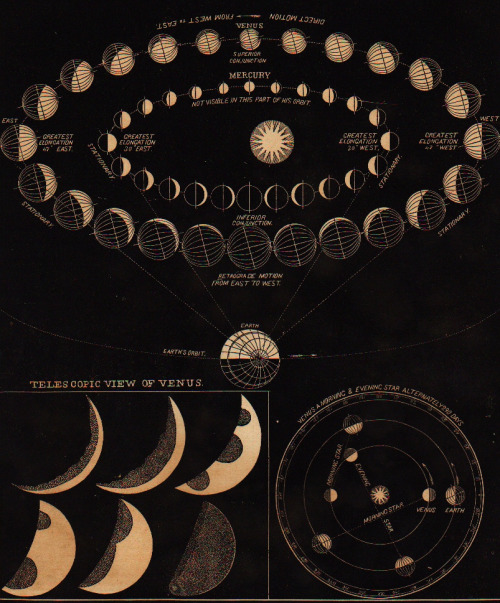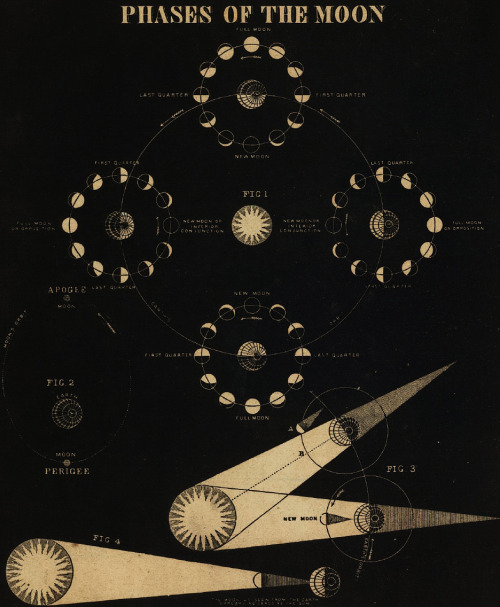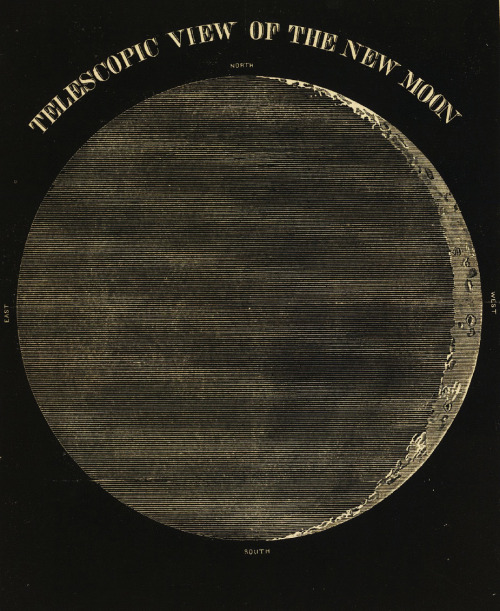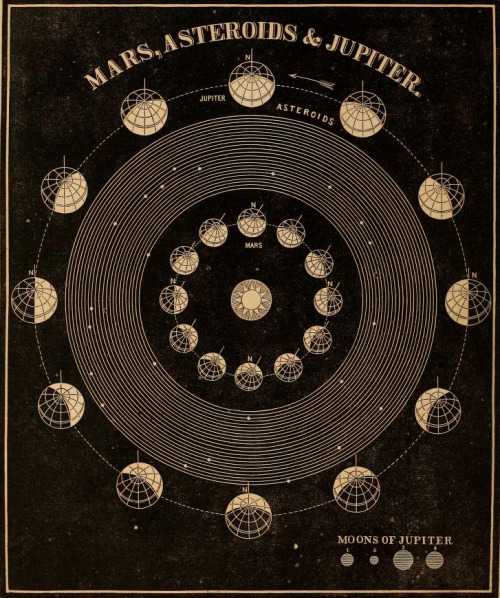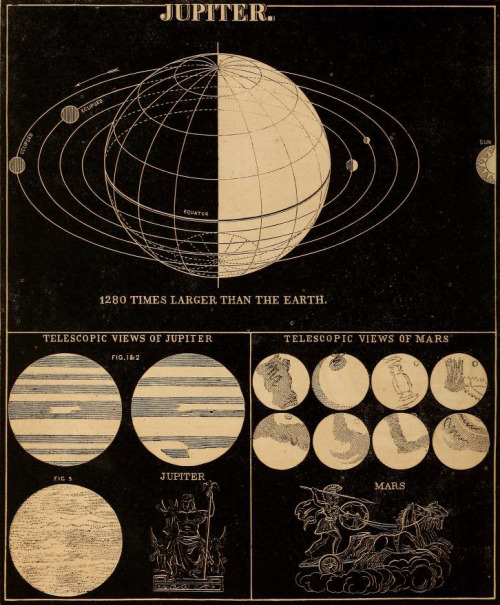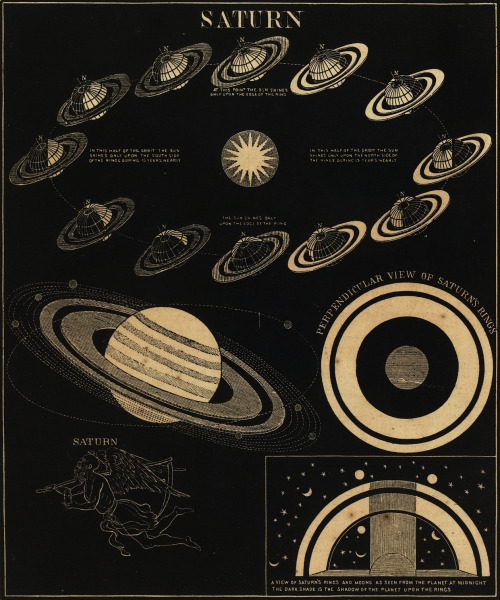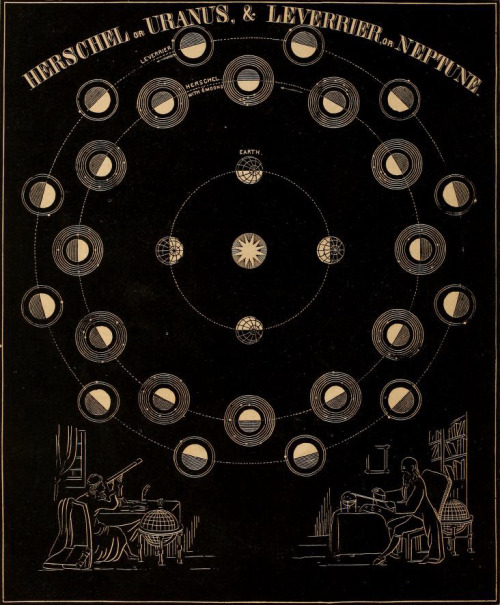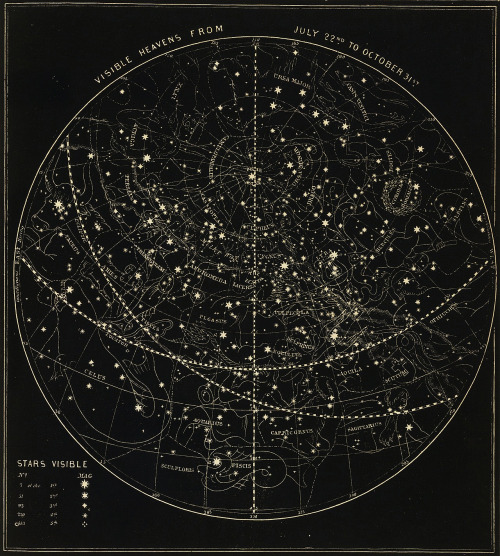If Earth Had Saturn’s Rings
If Earth had Saturn’s Rings
From an excellent post by Jason Davis
From Washington, D.C., the rings would only fill a portion of the sky, but appear striking nonetheless. Here, we see them at sunrise.

From Guatemala, only 14 degrees above the equator, the rings would begin to stretch across the horizon. Their reflected light would make the moon much brighter.

From Earth’s equator, Saturn’s rings would be viewed edge-on, appearing as a thin, bright line bisecting the sky.

At the March and September equinoxes, the Sun would be positioned directly over the rings, casting a dramatic shadow at the equator.

At midnight at the Tropic of Capricorn, which sits at 23 degrees south latitude, the Earth casts a shadow over the middle of the rings, while the outer portions remain lit.

via x
More Posts from Fillthevoid-with-space and Others










Black Holes Are Real And Spectacular, And So Are Their Event Horizons
“Originally estimated to be slightly larger than its M87 counterpart, the black hole at the center of the Milky Way — known as Sagittarius A* — has not yet had its event horizon imaged. When you observe the Universe, you don’t always get what you expect; sometimes, you get what it gives you. Instead, it was M87’s black hole that came through first, which was a much brighter and a much cleaner signal.
What we’ve found is spectacular. Those dark pixels at the center of the image are actually the silhouette of the event horizon itself. The light that we observe comes from the accelerated, heated matter around it, which must emit electromagnetic radiation. Where the matter exists, it emits radio waves, and the dark circle we see is where the background radio waves are blocked by the event horizon itself.”
We have an event horizon, folks! It wasn’t the one at the center of our galaxy that came through first, but rather the one at the center of Messier 87: a black hole over 1,000 times more massive, but some 2,000 times farther away, than the one contained in the Milky Way. This is an ultramassive black hole that’s almost the size of the entire Solar System, and its event horizon is real.
Come get the full story on what we know, now that we have our image, about black holes in the aftermath of the Event Horizon Telescope!

Did you know that when we classify stars, we’re comparing different types of stars but also stars at different stages of their life cycles? This is the second in a two-part episode about star classifications (go listen to Part 1 if you haven’t already; or listen to this one first and then listen to Part 1, it’s not exactly spoiler territory here). In this podcast, I talk about the various ways we've chosen to interpret observational data on stars, from observing the bright sky-dots to evaluating how bright they are by comparing them to each other, and all the new things we can do with new observational techniques. Never fear, Harvard observatory’s computers make a significant appearance again in this one!
I did my best to explain everything in as comprehensible terms as possible but you can hit me up with questions if you have them! I’m also on Twitter at @HDandtheVoid if you’d rather ask me there. And go ahead and check out the podcast on iTunes, rate it or review it if you’d like, and subscribe! I’ll always post all the extras here on tumblr but iTunes is probably more convenient for downloading.
Below the cut are my sources, music credits (thanks Elena for the filler music suggestion, very on-the-nose), vocab list, and the transcript. I mention a couple of books and quote a couple people in this episode so if you want to see that written down, those sources are there as well. Let me know what you think of this episode, let me know what you think I should research next*, tell me a fun space fact… anything’s helpful!
*(My thoughts were planets or looking into a couple major astronomers; either Edmond Halley or Tycho Brahe <3 or maybeStephen Hawking? Let me know by the 23rd so I can get a podcast up by July 3rd!)
Glossary:
Charge-Coupled Device (CCD) - a device that moves an electrical charge to shift the signal between incoming photons to turn them into electron charges that can then be read as an image. It’s used in digital cameras and in astronomy for UV-to-infrared applications.
deep-sky object - any cosmological object that isn’t individual stars or something from our Solar System. It’s a classification that includes nebulae, galaxies, and star clusters, and it has its roots in amateur astronomy.
Hipparcos satellite - the European Space Agency ‘high precision parallax collecting satellite’ that operated between 1989 and 1993. It gathered astronomical and photometric data of stars and was highly accurate in positioning and cataloging the star information it acquired on its four-year mission. Its data was published in 1997 in two catalogs: the Hipparcos Catalogue, distributed in print as well as on CDs and mapped 118,218 stars; and the Tycho Catalogue, distributed only on CDs and mapped 1,058,332 stars. The Tycho-2 Catalogue was an updated version of the Tycho Catalogue made with more refined imaging techniques and re-released on CDs and online in 2000 with over 2 million stars mapped.
neutron star - a type of star that has gone supernova, when the surviving core is 1.5 to 3 solar masses and contracts into a small, very dense, very fast-spinning star.
pulsar - a type of neutron stars that spins very, very fast: a kind of variable star that emits light pulses usually between 0.0014 seconds and 8.5 seconds.
stellar photometry/photometrics - measuring the brightness of stars and the changes of brightness over time. Previously used photographic plates and visual equipment in professional observatories, but shifted after an international photoelectric system was established in 1951. Currently we use photoelectric devices, such as CCDs.
stellar spectra classification - developed at Harvard Observatory in the 20th century, a categorization of stars based on stellar surface temperatures rather than actual compositional differences, gravity, or luminosity in stars. From highest temperature to lowest, the seven main stellar types are O, B, A, F, G, K, and M. O, B, and A type stars are often referred to as early spectral types, while cool stars like G, K, and M are known as late type stars, even though these titles are based in disproven ideas about stellar evolution.
Script/Transcript
Sources:
Standard stellar types via University of College London
List/timeline of major historical star catalogs
A brief history of early star catalogs, since the International Astronomical Union made a new star catalog in 2016.
A history of the Messier list
A history of the Messier List and how amateur astronomers use it
The Messier List
A really detailed Messier List, including Messier’s own observations on the object along with what it is currently understood to be
`Deep Sky Observers Companion online database
The Caldwell List via SEDS
The Caldwell List via the Astronomical League
Translation of ‘Durchmusterung’ via PONS online translation
Some hilarious mnemonics that are an alternative to the girl-kissing one to remember the order of stellar spectra. I don't know why there’s an entire page dedicated to this but good on you, Caltech.
Photometry overview via the Astronomical Society of South Australia
Hipparcos Catalog via NASA
History of the Hipparcos satellite and subsequent catalogs via ESA
Tycho-2 Catalog via NASA
The Hipparchos and Tycho catalogues online and downloadable if you have a whole lot of storage space to put them in
The U.S. Navy’s Naval Meteorology and Oceanography Command website has a list of recommended informational catalogs, last updated in November 2004
Information on current star charts, specialized and general, and how to download them
The Research Consortium on Nearby Stars’ website, working on cataloging and characterizing all stars within 10 parsecs/32.6 light years of Earth
The Smithsonian Astrophysical Observatory star catalog, which goes to V=9. Please don’t ask me how the hell it works, I didn’t bother ordering it
Another SAO catalog via NASA’s High Energy Astrophysics Science Archive Research Center website
If you can figure out how to navigate this catalog, you should probably take over this podcast for me.
Soba, Dava. The Glass Universe: How the Ladies of the Harvard Observatory Took the Measure of the Stars. Viking: New York, 2016.
“After all, astronomers could not yet tie any given traits of stars, such as temperature or age, to the various groupings of spectral lines. What they needed was a consistent classification—a holding pattern for the stars—that would facilitate fruitful future research” (91).
“A good number of other blank spaces in her tables pointed up other lacunae, such as missing minimum values, uncertain periods, absent spectra, or questionable variable type” (113).
Annie Jump Cannon: “Since I have done almost all the world’s work in this one branch, it was necessary for me to do most of the talking” (158)
Ogilvie, Marilyn Bailey. Women in Science: Antiquity Through the Nineteenth Century. MIT P: Cambridge, MA, 1986. Located in Google Books preview.
Mack, Pamela E. “Straying from Their Orbits: Women in Astronomy in America.” In Women of Science: Righting the Record. Ed. Gabriele Kass-Simon, Patricia Farnes, Deborah Nash. Indiana U P: Bloomington, IN, 1993 (72-116). Located in Google Books preview.
Selin, Helaine. “Battani” Encyclopaedia of the History of Science, Technology, and Medicine in Non-Western Cultures. Springer Science & Business Media: Berlin, Germany, 2011. Located in Google Books preview.
Intro Music: ‘Better Times Will Come’ by No Luck Club off their album Prosperity
Filler Music: ‘Champagne Supernova’ by Oasis off their album (What’s the Story) Morning Glory?
Outro Music: ‘Fields of Russia’ by Mutefish off their album On Draught

LUCIDA
[noun]
the brightest star in a constellation.
Etymology: from the full phrase in Latin stella lūcida meaning “bright star”. Lucida can be traced to the Latin verb lūcēre, "to shine,“ from lux, "light.”
[Tim Barton - Amber of the Void]


I imagine most people wanted to be astronauts when they learned it was a job they could have - I certainly did! And then I thought about it and realized podcasting about outer space was much less scary and much more achievable than becoming an astronaut, with the bonus of not having to wonder how hard I’d panic in an enclosed-yet-surrounded-by-vastness space. There have been a lot of people braver than me who went to space, and some of them went to space on long-term missions lasting months or a year, living on the International Space Station (or the historical equivalent, depending on when in history this happened). Learn what resources are available to ISS astronauts, and what risks there are out there (apart from the obvious ones).
Sorry I missed last week, but it was New Year’s and I don’t feel very guilty. Get excited about more space podcasts in 2018, though! Below the cut are my sources, music credits, a vocab list, and the transcript of this episode. I bolded any videos or sources that I mentioned in the podcast, if you’re looking for those specifically. Go ahead and suggest what you think I should research next by messaging me here, tweeting at me at @HDandtheVoid, or asking me to my face if you know me. Please subscribe on iTunes, rate it and maybe review it, and tell friends if you think they’d like to hear it!
(My thoughts on the next episode are more about astronauts, or I could go into the transit of Venus. I have a couple books about space I should really get into reading… The next episode will go up January 22nd.)
Glossary
free fall - the downward movement of an object that is due to the force of gravity alone.
gravity - the phenomenon which causes all things with mass to move towards each other. On the universal scale, this is caused by the warping of spacetime by objects with large mass, e.g. stars and planets, and is explained through Einstein’s theory of general relativity.
microgravity - the state of perpetual free fall in a gravity field.
orbit - the gravitationally curved trajectory of an object, e.g. the trajectory of a satellite around a planet.
Script/Transcript
Sources
Yuri Gagarin via NASA
Microgravity via NASA (Feb 2012)
The history of astronaut life via the Smithsonian Air and Space Museum
Menstruation in space via National Geographic (Apr 2016)
The Air We Breathe via the Smithsonian Environmental Research Center
Breathing Easy on the Space Station via NASA (Nov 2000)
Jay Perry: “the chemical-mechanical systems are much more compact, less labor intensive, and more reliable than a plant-based system.”
Astronaut’s Home Videos Show How to Cook in Space via Space.com (Mar 2013)
Astronaut Hygiene: How to Wash Your Hair In Space (Video) via Space.com (July 2013)
Interview with former astronaut Prof. Jeremy Hoffman via the University of Leicester
A day in the life aboard the International Space Station via NASA (2015)
Zvezda Module Overview via NASA
Food for Space Flight via Nasa (Feb 2004)
John Glenn via NASA (Feb 2012)
Crew From U.S., Russia and Japan Expands Space Population to Six via NASA (Dec 2017)
ISS blog with experiment updates via NASA
Astronaut daily life via ESA (Nov 2012)
The Skylab 4 Mutiny, 1973 via libcom.org (Apr 2004)
Carr: “On the ground, I don’t think we would be expected to work a 16-hour day for 85 days, and so I really don’t see why we should even try to do it up here.”
‘Space Oddity’ by Chris Hadfield via YouTube
Interview with astronaut Chris Hadfield via NPR (Oct 2013)
Col. Chris Hadfield: “The contrast of your body and your mind inside … essentially a one-person spaceship, which is your spacesuit, where you’re holding on for dear life to the shuttle or the station with one hand, and you are inexplicably in between what is just a pouring glory of the world roaring by, silently next to you — just the kaleidoscope of it, it takes up your whole mind. It’s like the most beautiful thing you’ve ever seen just screaming at you on the right side, and when you look left, it’s the whole bottomless black of the universe and it goes in all directions. It’s like a huge yawning endlessness on your left side and you’re in between those two things and trying to rationalize it to yourself and trying to get some work done.”
Excerpt from memoir by former astronaut Scott Kelly via the Sunday Morning Herald (Oct 2017)
Intro Music: ‘Better Times Will Come’ by No Luck Club off their album Prosperity
Filler Music: ‘Major Tom’ by Shiny Toy Guns off their album Major Tom.
Background Music: ‘Leaves’ by Patients aka Ben Cooper, who primarily releases music as Radical Face but also has at least three other bands or band names he’s working with/has released music as.
Outro Music: ‘Fields of Russia’ by Mutefish off their album On Draught

Scott Kelly just tweeted this photo of the Moon, Venus, Jupiter and Earth as seen from the International Space Station
js
Heads up, this is tomorrow night! I hope it's clear where I am to see it but considering I'm in the Pacific Northwest, I don't have super high hopes. Get a look if you can, though! Rare to see a blue moon that's actually red :)
A Total Lunar Eclipse is Coming: 10 Things to Know
If you were captivated by August’s total solar eclipse, there’s another sky show to look forward to on Jan. 31: a total lunar eclipse!

Below are 10 things to know about this astronomical event, including where to see it, why it turns the Moon into a deep red color and more…
1. First things first. What’s the difference between solar and lunar eclipses? We’ve got the quick and easy explanation in this video:
2. Location, location, location. What you see will depend on where you are. The total lunar eclipse will favor the western U.S., Alaska, Hawaii, and British Columbia on Jan. 31. Australia and the Pacific Ocean are also well placed to see a major portion of the eclipse, if not all of it.

3. Color play. So, why does the Moon turn red during a lunar eclipse? Here’s your answer:
4. Scientists, stand by. What science can be done during a lunar eclipse? Find out HERE.
5. Show and tell. What would Earth look like from the Moon during a lunar eclipse? See for yourself with this artist’s concept HERE.
6. Ask me anything. Mark your calendars to learn more about the Moon during our our Reddit AMA happening Monday, Jan. 29, from 3-4 pm EST/12-1 pm PST.

7. Social cues. Make sure to follow @NASAMoon and @LRO_NASA for all of the latest Moon news leading up to the eclipse and beyond.
8. Watch year-round. Can’t get enough of observing the Moon? Make a DIY Moon Phases Calendar and Calculator that will keep all of the dates and times for the year’s moon phases right at your fingertips HERE.

Then, jot down notes and record your own illustrations of the Moon with a Moon observation journal, available to download and print from moon.nasa.gov.
9. Lesson learned. For educators, pique your students’ curiosities about the lunar eclipse with this Teachable Moment HERE.
10. Coming attraction. There will be one more lunar eclipse this year on July 27, 2018. But you might need your passport—it will only be visible from central Africa and central Asia. The next lunar eclipse that can be seen all over the U.S. will be on Jan. 21, 2019. It won’t be a blue moon, but it will be a supermoon.
Make sure to follow us on Tumblr for your regular dose of space: http://nasa.tumblr.com.
-
 winterhuntsman liked this · 3 weeks ago
winterhuntsman liked this · 3 weeks ago -
 mirandalambert-1 liked this · 2 months ago
mirandalambert-1 liked this · 2 months ago -
 cloudystormz reblogged this · 4 months ago
cloudystormz reblogged this · 4 months ago -
 artzandfashion reblogged this · 5 months ago
artzandfashion reblogged this · 5 months ago -
 flowerfemmes reblogged this · 5 months ago
flowerfemmes reblogged this · 5 months ago -
 annao1qp6 liked this · 6 months ago
annao1qp6 liked this · 6 months ago -
 vrdnblaze liked this · 6 months ago
vrdnblaze liked this · 6 months ago -
 annau902a liked this · 6 months ago
annau902a liked this · 6 months ago -
 versexinspo reblogged this · 7 months ago
versexinspo reblogged this · 7 months ago -
 moefug-lyte reblogged this · 7 months ago
moefug-lyte reblogged this · 7 months ago -
 alanis5459 liked this · 8 months ago
alanis5459 liked this · 8 months ago -
 eelmanson reblogged this · 8 months ago
eelmanson reblogged this · 8 months ago -
 eelmanson liked this · 8 months ago
eelmanson liked this · 8 months ago -
 armyofone reblogged this · 8 months ago
armyofone reblogged this · 8 months ago -
 littlelilliana15 liked this · 9 months ago
littlelilliana15 liked this · 9 months ago -
 warcotuj8746 liked this · 9 months ago
warcotuj8746 liked this · 9 months ago -
 doutor-gato liked this · 11 months ago
doutor-gato liked this · 11 months ago -
 magpants reblogged this · 11 months ago
magpants reblogged this · 11 months ago -
 xsolar-ghost reblogged this · 11 months ago
xsolar-ghost reblogged this · 11 months ago -
 martin-luther-on-my-mind liked this · 11 months ago
martin-luther-on-my-mind liked this · 11 months ago -
 soyleader liked this · 1 year ago
soyleader liked this · 1 year ago -
 grasshelmet liked this · 1 year ago
grasshelmet liked this · 1 year ago -
 skalecsz reblogged this · 1 year ago
skalecsz reblogged this · 1 year ago -
 triforce-of-dinner liked this · 1 year ago
triforce-of-dinner liked this · 1 year ago -
 stalpra-and-100-fandoms reblogged this · 1 year ago
stalpra-and-100-fandoms reblogged this · 1 year ago -
 alexandraisapenguin liked this · 1 year ago
alexandraisapenguin liked this · 1 year ago -
 juzo liked this · 1 year ago
juzo liked this · 1 year ago -
 likelocket reblogged this · 1 year ago
likelocket reblogged this · 1 year ago -
 irish-agender-moss liked this · 1 year ago
irish-agender-moss liked this · 1 year ago -
 maxwaspace liked this · 1 year ago
maxwaspace liked this · 1 year ago -
 starlitpath7 reblogged this · 1 year ago
starlitpath7 reblogged this · 1 year ago -
 justremainingmyself reblogged this · 1 year ago
justremainingmyself reblogged this · 1 year ago -
 justremainingmyself liked this · 1 year ago
justremainingmyself liked this · 1 year ago -
 18nth liked this · 1 year ago
18nth liked this · 1 year ago -
 patchworkideas reblogged this · 1 year ago
patchworkideas reblogged this · 1 year ago -
 lamaenthel-2 reblogged this · 1 year ago
lamaenthel-2 reblogged this · 1 year ago -
 occipita reblogged this · 1 year ago
occipita reblogged this · 1 year ago -
 oblivionates liked this · 1 year ago
oblivionates liked this · 1 year ago -
 reiyacchi liked this · 1 year ago
reiyacchi liked this · 1 year ago -
 revnren reblogged this · 1 year ago
revnren reblogged this · 1 year ago -
 revnren liked this · 1 year ago
revnren liked this · 1 year ago -
 ahugefanofbooks liked this · 1 year ago
ahugefanofbooks liked this · 1 year ago -
 notadwarf-planet liked this · 1 year ago
notadwarf-planet liked this · 1 year ago -
 h0n3yk1tt3n reblogged this · 1 year ago
h0n3yk1tt3n reblogged this · 1 year ago
A podcast project to fill the space in my heart and my time that used to be filled with academic research. In 2018, that space gets filled with... MORE SPACE! Cheerfully researched, painstakingly edited, informal as hell, definitely worth everyone's time.
243 posts



